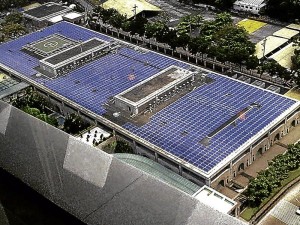ADB ‘LEEDing’ way to green growth
In a world where valuable resources are steadily depleting, it is only but proper and fitting for its inhabitants to lay down measures that will help arrest this alarming decline.
This is perhaps why in the Philippines, and elsewhere in the world, governments and large corporations alike are strongly advocating sustainable economic growth, through which they are able to secure their respective businesses over the long term and at the same time, ensure the holistic and inclusive growth of affected stakeholders and the environment.
The Manila-based Asian Development Bank (ADB), for one, believes in the wisdom of creating sustainable structures, as evident in its support for “green growth” in developing member countries and in the way it has put up its headquarters in Ortigas in the ’90s.
“We at ADB invest in sound environmental and natural resource management, while promoting green growth, low carbon development and adaptation to climate change. We also work with our development partners to enhance environmental governance and management capacity,” a report from the ADB stated.
New rooftop solar power
The proof of ADB’s commitment to green growth has again been shown more recently through its rooftop solar power project, which is now providing clean, renewable energy to the bank’s 20-year-old headquarters.
Such a measure is not entirely a new undertaking for the ADB, as the 143,570-sq m headquarters, which was constructed in 1991, has then already been a model of green building technology. Being aware of the country’s tropical climate, ADB knew that a balance of natural architecture and technological innovation is crucial for the building to save energy and ensure human comfort.
“The building was designed with gardens and courtyards to increase shade. Atriums and tinted windows let in the right amount of light while reducing heat from the sun to save energy,” ADB said.
“On a typical day, 3,500 people work in and use the facilities of our headquarters, almost 1,600 meals are prepared in our kitchens and 407,000 liters of water flow through our pipes. Each factor holds potential environmental impacts. So we must continually work hard to reduce the impact of our headquarter’s activities on the environment and to meet the challenges of accelerating climate change,” it further noted.
Certifiably green
According to this multilateral lender, its efforts have been met with such success that last year, the ADB office complex received the Leadership in Energy and Environmental Design (LEED) certification for existing buildings—thus making its headquarters certifiably green.
LEED certification, ADB recounted, was not easily earned and must be rectified by meeting increasingly stringent requirements every five years, giving ADB that opportunity to make its Ortigas headquarters even greener in the years ahead.
In all these, ADB has strived to stay attuned to and updated with the latest environmental technology available and has steadily incorporated new and better ways of reducing its carbon footprint in its operations.
“To achieve LEED certification, ADB’s existing procedures on energy and environmental management were upgraded and reinforced to meet LEED requirements. By receiving 63 points, the ADB headquarters leapfrogged the ‘certified’ and ‘silver’ levels to achieve LEED Gold rating,” ADB noted.
Measures, practices
Meanwhile, here are some of those measures and practices that ADB has put in place to acquire the coveted LEED gold rating.
In 2003, ADB has implemented measures called integrated environment, health and safety management system (EHSMS) certified under ISO 14001 and OSHAS 2 18001.
“These systems called for documenting procedures, developing guidelines and training and encouraging staff to support the environmental three ‘Rs’—reduce, reuse and recycle. We were certified that same year,” ADB related.
Heat reduction from the tree shading of open car parks, the high solar reflectance index of ADB’s paved roadway and environment-friendly transportation options has also helped it earned the needed LEED points.
Another factor that contributed to ADB’s Gold rating is the management of storm water.
“Our new rainwater-harvesting facility has reduced rainwater runoff by more than 30 percent and to qualify for LEED certification we also reduced outside light pollution through full and partial shielding of exterior lights that are above 50 watts,” ADB said.
The practice of water efficiency also helped ADB earn its Gold rating. The principle of water efficiency explained that ADB focuses on plumbing, water performance measurement, water-efficient landscaping and cooling tower management both inside and outside the building.
“Water is used at ADB headquarters for everything from watering plants and facilities cleaning to preparing food in our kitchens and providing for toilets and showers,” it said.

